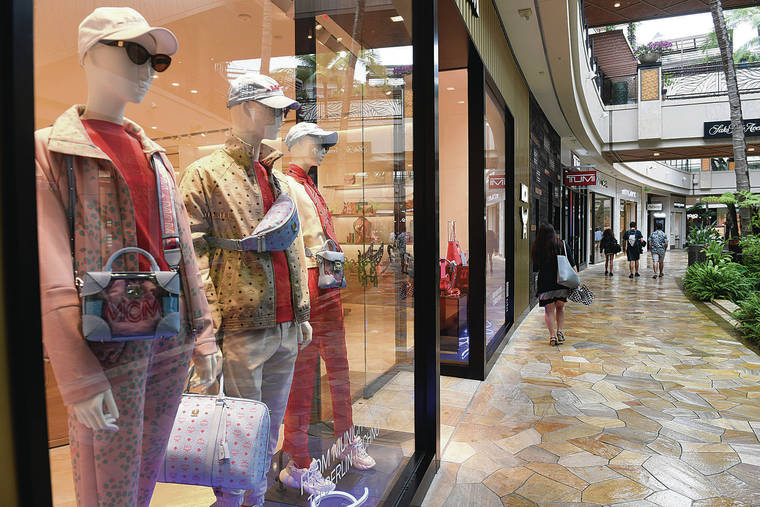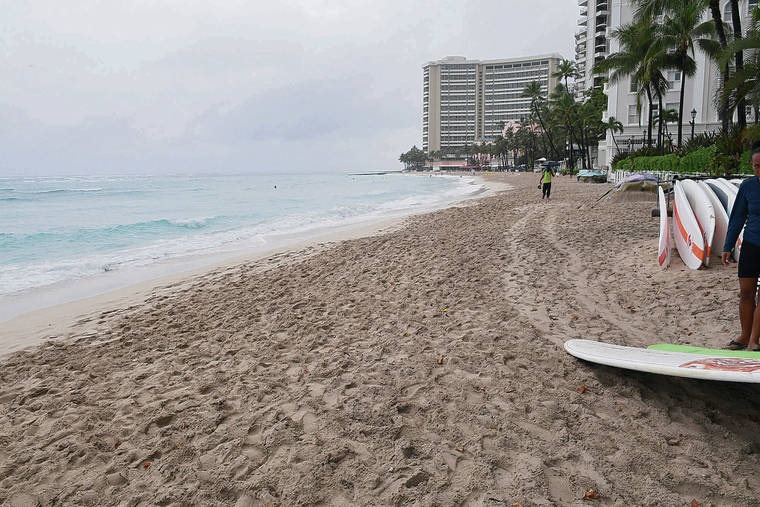Tourism reels as containment prompts further declines

BRUCE ASATO / BASATO@STARADVERTISER.COM
A pedestrian passes a window display in the International Market Place with less than the usual crowds of visitors.

BRUCE ASATO / BASATO@STARADVERTISER.COM
The scene at Kuhio Beach shows the scarcity of beachgoers, exacerbated by rain.


If Americans follow recommendations issued Monday by the White House to halt the spread of COVID-19, Hawaii’s declining visitor industry will shrink even more — perhaps to proportions that cause greater negative economic impacts than 9/11.
The recommendations, which apply to at least the next 15 days, urge Americans not to gather in groups of more than 10 people and to avoid discretionary travel. They call for people to avoid social visits and use drive-thru, pickup or delivery options instead of eating or drinking at bars, restaurants and food courts. Older people, and those with health conditions that would make them more susceptible to COVID-19, are encouraged to stay home.
The guidelines weren’t an outright ban on tourism — medical and essential travel hasn’t been discouraged. And given COVID-19’s spread, some might argue they didn’t go far enough. Some local governments have implemented much stricter policies, including San Francisco and six other counties in California’s Bay Area, which have ordered residents to “shelter in place” through at least April 7 with only essential businesses open.
>> Photo Gallery: Fewer tourists in Waikiki during coronavirus scare Opens in a new tab
Both will add to significant cutbacks in flights from carriers that serve Hawaii, which is mostly a leisure destination. To be sure, it’s hard to practice social distancing on planes, which typically carry well over 10 times the new coronavirus-inspired group limits.
Just how bad is it? Hawaii’s largest domestic carrier, United Airlines, has announced an approximately 50% cut in capacity for April and May.
Don't miss out on what's happening!
Stay in touch with breaking news, as it happens, conveniently in your email inbox. It's FREE!
“We also now expect these deep cuts to extend into the summer travel. Even with those cuts, we’re expecting load factors to drop into the 20-30% range — and that’s if things don’t get worse,” wrote Oscar Munoz, United’s CEO, and J. Scott Kirby, United’s president, in a Sunday letter to employees.
Peter Ingram, CEO and president of Hawaii’s biggest carrier, Hawaiian Airlines, sent a message Monday to HawaiianMiles members that the carrier will make 15% to 20% cuts to its systemwide capacity in April and May.
“In the current circumstances we cannot offer assurances that this will be the last time we need to make significant near-term changes to our operations,” Ingram said in the message.
On Friday, Delta Air Lines announced a 40% schedule reduction, and the list goes on. Airlines for America, the nation’s airline industry trade group, is calling for immediate assistance — grants, loans and tax relief — in an economic climate that it says has grown unsustainable and is getting worse by the day.
The flight reductions already have left Hawaii in a tough spot. Only about 143,000 of last year’s visitor arrivals didn’t come by air. Those visitors came by cruise ships, which also are making reductions. Carnival, Royal Caribbean, Norwegian and MSC Cruises have agreed to suspend trips from the U.S. for 30 days. The new safety guidelines also could chip away at arrivals from Hawaii’s large domestic market, which accounted for roughly 7.3 million of last year’s 10.4 million visitors.
Paul Brewbaker, principal at TZ Economics, said, “There’s the bad, the worse and then the awful scenario. We are probably in the worse trying to prevent things from getting really awful.”
While kamaaina on spring break are helping to offset some of Hawaii’s tourism decline, given the circumstances, they aren’t as active. A flurry of cancellations from the group meetings, conventions and incentives market also is creating large swaths of hotel vacancies that are hard to fill even from West Coast markets that normally respond to specials with short-booking windows.
Jack Richards, Pleasant Holidays CEO and president, said, “The federal government has not stepped in and restricted domestic travel yet, but they are telling everybody, ‘Don’t get on airplanes, don’t travel unless you have to.’ The collateral damage is going to impact Hawaii.”
Richards said cancellations also are growing from visitors who were planning to come from places where local travel restrictions were implemented.
“San Francisco did a lockdown of stay in place — that’s shutting it down. Also, various cities all up and down the East Coast, West Coast, Midwest are enacting measures to close restaurants, pubs, bars and nightclubs, nonessential businesses,” Richards said. “That’s going to pretty much cut out all short-term travel to Hawaii for at least the next two to four weeks, maybe more.”
Teri Orton, general manager of the Hawai‘i Convention Center, said the facility has had 21 cancellations in the last four days. While most are local, Orton said an association that planned to bring 3,000 global attendees to Hawaii in April also might cancel.
“If all 21 of the groups cancel, it will be the equivalent of a $1 million drop in revenue,” Orton said. “I’m hoping that some of them will postpone their events to later this year or into next year.”
Orton said meeting planners for the offshore business booked later this year are taking a “wait-and-see” approach. The center’s largest group of the year, the 2020 Rotary International Convention, still is slated to bring just under 20,000 attendees to Honolulu from June 6 to 10, she said.
“We are hopeful that things will take a turn,” Orton said.
Brewbaker said before COVID-19 became a pandemic, a more hopeful scenario anticipated Hawaii tourism would pass the downturn by spring and enter recovery by summer. But he clarified that a 50% reduction in travel, symbolized by some of the airline announcements, would definitely put COVID-19 within the range of 9/11, which hit Hawaii’s tourism-dependent economy hard.
“Tourism is still the biggest game in town. We’re talking about 17% to 18% of the economy (in terms of GDP), and let’s say half of it goes away, so that’s the equivalent of … the military going away overnight. The military is about 7% to 8% GDP,” Brewbaker said.
Carl Bonham, executive director of the University of Hawaii Economic Research Organization, said passenger counts were holding in February, and some leftover positives carried over into March. But he said April and May numbers are dropping to the point that Waikiki hotel occupancy could easily fall to 50% or below.
“Obviously, this new announcement doesn’t help with that,” Bonham said. “It’s about stopping spread, which, long term, is more important than the initial negative impact on the economy.”
For 2020, Bonham expects that Hawaii’s drop in visitors and visitor spending “is going to be bigger than 9/11.”
“In our low scenario, it was fairly close to the 9/11 drop — about a 10% drop in arrivals and 15% in visitor spending for the year. When we release a forecast update, I’ll be very surprised if we don’t have an outlook that’s worse than that,” he said.
Part of the reason Bonham anticipates further dampening is that COVID-19 is “no longer just a tourism event. It’s affecting the global economy.”
“We’re revising our forecast for the U.S., and we expect the U.S. economy to have a recession. We expect Hawaii’s economy will have a recession,” he said. “People would be making choices about whether they are going to eat out or take a vacation not just based on social distancing, but also based on their own financial situation and what they expect to happen.”




